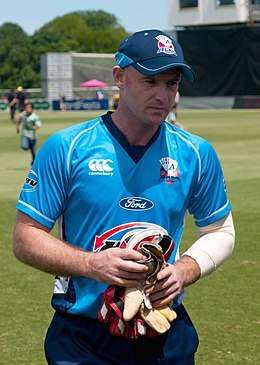Gareth Hopkins
Gareth James Hopkins (born 24 November 1976) is a former New Zealand cricketer. A wicket-keeper, he played five One Day Internationals in 2004 after Brendon McCullum went home from England for the NatWest series.
 | ||||||||||||||||||||||||||||||||||||||||||||||||||||||||||||||||||
| Personal information | ||||||||||||||||||||||||||||||||||||||||||||||||||||||||||||||||||
|---|---|---|---|---|---|---|---|---|---|---|---|---|---|---|---|---|---|---|---|---|---|---|---|---|---|---|---|---|---|---|---|---|---|---|---|---|---|---|---|---|---|---|---|---|---|---|---|---|---|---|---|---|---|---|---|---|---|---|---|---|---|---|---|---|---|---|
| Full name | Gareth James Hopkins | |||||||||||||||||||||||||||||||||||||||||||||||||||||||||||||||||
| Born | 24 November 1976 Lower Hutt, Wellington, New Zealand | |||||||||||||||||||||||||||||||||||||||||||||||||||||||||||||||||
| Batting | Right-handed | |||||||||||||||||||||||||||||||||||||||||||||||||||||||||||||||||
| Role | Wicket-keeper | |||||||||||||||||||||||||||||||||||||||||||||||||||||||||||||||||
| International information | ||||||||||||||||||||||||||||||||||||||||||||||||||||||||||||||||||
| National side |
| |||||||||||||||||||||||||||||||||||||||||||||||||||||||||||||||||
| Test debut (cap 240) | 5 June 2008 v England | |||||||||||||||||||||||||||||||||||||||||||||||||||||||||||||||||
| Last Test | 20 November 2010 v India | |||||||||||||||||||||||||||||||||||||||||||||||||||||||||||||||||
| ODI debut | 29 June 2004 v England | |||||||||||||||||||||||||||||||||||||||||||||||||||||||||||||||||
| Last ODI | 1 July 2008 v Ireland | |||||||||||||||||||||||||||||||||||||||||||||||||||||||||||||||||
| ODI shirt no. | 48 | |||||||||||||||||||||||||||||||||||||||||||||||||||||||||||||||||
| T20I debut (cap 27) | 23 November 2007 v South Africa | |||||||||||||||||||||||||||||||||||||||||||||||||||||||||||||||||
| Last T20I | 23 May 2010 v Sri Lanka | |||||||||||||||||||||||||||||||||||||||||||||||||||||||||||||||||
| Career statistics | ||||||||||||||||||||||||||||||||||||||||||||||||||||||||||||||||||
| ||||||||||||||||||||||||||||||||||||||||||||||||||||||||||||||||||
Source: Cricinfo, 16 April 2014 | ||||||||||||||||||||||||||||||||||||||||||||||||||||||||||||||||||
International career
Gareth Hopkins returned to the international scene playing two matches in the Chappell–Hadlee one day series. The second match of the series and Hopkins' first was heavily rain affected, New Zealand reaching 3/30 when the game came to a close. The second and final match was won by Australia by a convincing 114 runs, Hopkins contributing 9 off 17 balls.
Hopkins made his test debut on 5 June 2008 against England at Trent Bridge, as usual Wicket-keeper Brendon McCullum played in a specialist batsman role. He contributed a total of 27 runs and took 3 catches in New Zealand's innings defeat.
Domestic career
In the summer of 2007/08, he transferred from Otago to Auckland citing the fact that Otago had recruited Brendon McCullum from Canterbury. The move was surprising considering Hopkins scored 5 1st class hundreds for Otago in the summer of 2006/07.
External links
| Wikimedia Commons has media related to Gareth Hopkins. |
- Gareth Hopkins at ESPNcricinfo
- Gareth Hopkins at New Zealand Cricket Players Association